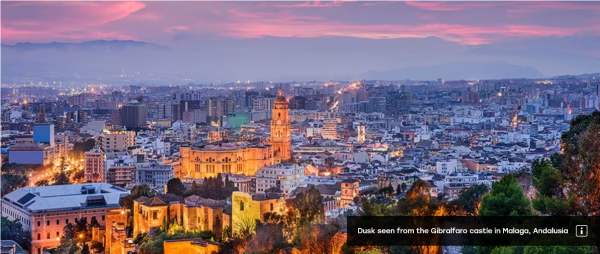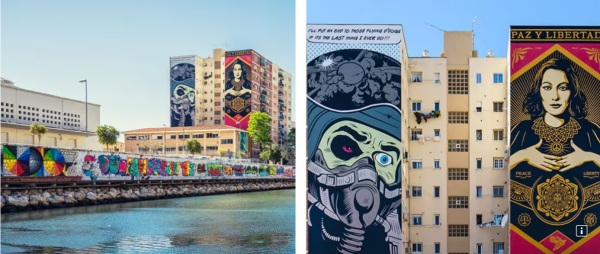SINGAPORE, 1 December 2023: Malaga has been experiencing a cultural upheaval in the past few years. The birthplace of Pablo Picasso, it has some of the most interesting ‘last-decade museums’. Daring street art has sprung up in neighbourhoods like the Barrio de las Artes. You’ll probably wish you had more time to really explore the capital of the Costa del Sol, but it’s the perfect excuse to go back another time.
DAY 1
For your first day in Malaga, explore the old town centre, with stops at the most important museums and sights.
A walk around the historic centre
Kick off the morning on the city’s most iconic street, Calle Larios, a lively and bustling pedestrianised shopping area to give you a taste of Malaga’s great atmosphere. If you’re here at Christmas, be sure to see the amazing light and music show on this street.
A 5-minute walk brings you to the Cathedral or Basílica de la Encarnación, called “La Manquita” (the one-armed lady) because construction stopped before the southern tower could be finished, leaving it asymmetrical. A visit to the cathedral roof, nearly 50 metres up, is a must. Back at street level, you can enjoy the charming Calle de San Agustín, a street bringing you to the Picasso Museum Malaga, with over 230 works by the city’s most famous son.
Local dishes and centuries of history
Your next stop might be La Alcazaba, the fortress-palace the Muslim governors built on Mount Gibralfaro in the 11th century. At its feet, there is a Roman theatre, which was in use until the 3rd century CE.
This is a great place for lunch, with unspoiled traditional eating houses nearby, such as El Pimpi. You can have the traditional post-lunch coffee in the sunshine at one of the pavement cafés in Plaza de la Merced. Just off this square is a very special location, the Picasso Foundation and Birthplace Museum. This is the house where Picasso was born and spent his childhood. Very close by is the church of Santiago, where Picasso was baptised.
Sunset from a castle
Do you remember La Alcazaba, which we suggested seeing before lunch? You probably noticed that the palace is connected to a castle, the Castillo de Gibralfaro. There is one entrance for both buildings.
If you don’t have a car, the best way to get up the hill to the castle is to catch a number 35 bus on Paseo del Parque. Once you arrive, there is a visitors’ centre where you can learn about the castle’s history. But the best thing it offers is the fabulous views over the city, the Bay of Malaga and La Malagueta bullring.

DAY 2
We’re right on the Mediterranean, so today you can get to know the seaside city. Before you hit the beach, we suggest exploring Malaga’s more modern and rebellious side. This neighbourhood is known as Barrio de las Artes, the city’s street art centre. The area between Avenida de la Alameda Principal and the dock at Muelle Heredia is where you’ll find CAC Málaga – the Malaga Contemporary Art Centre. A former wholesale market display works by Juan Muñoz, Tony Cragg and Sigmar Polke. While you’re here, you could have breakfast in one of the cosy local cafés.
On the seafront
One of Malaga’s most popular areas to visit is the Pedragalejo Esplanade. It’s a little way out of the city, but you can get there on a number 11 or 34 bus. This area is famous for its snack bars on the beach and restaurants next to the sea. This is the time to try boquerones (fresh anchovies), fritura malagueña (mixed fried fish) and especially espetos de sardinas (sardines on a skewer), a classic local dish. As you walk around, you’ll notice little boats full of sand, where the fires are made for charcoal-grilling the sardines.

Afternoon on Paseo de la Farola and Muelle 1
Back in the city, you can stick with the seaside theme with a visit to Malagueta Beach. Next to it is Muelle 1, a shopping and leisure area where you can take the opportunity to buy a souvenir. It’s also home to one of the city’s new landmarks, a giant coloured cube, the Centre Pompidou Malaga, with works by Francis Bacon, Alexander Calder, and Marc Chagall.
Alternatively, go back towards Muelle 2 and stroll along El Palmeral de las Sorpresas to get back to the old town centre. In this harbour area, there is an enormous Ferris wheel, 70 metres tall, which makes for a great viewing point.
(Source: Spain Tourism Board – Southeast Asia, Australia & New Zealand)
For the full report on how to explore Malaga.
For more on Spain’s travel experiences, visit https://www.spain.info/en/





